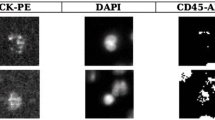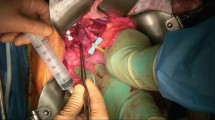Abstract
Background
The current study was conducted to clarify the frequency of systemic circulating tumor cells (CTCs) appearing after surgery for renal cell carcinoma and to evaluate the differences in postoperative CTCs between different surgical procedures.
Methods
This prospective, cohort study included 60 consecutive patients who underwent laparoscopic radical nephrectomy (RN) (n = 22), laparoscopic partial nephrectomy (PN) (n = 19), open RN (n = 8), or open PN (n = 11). In this study CTCs were measured by the FISHMAN-R system, and CTCs drawn from a peripheral artery were collected just before and immediately after surgery. The number of pre- and postoperative CTCs and the perioperative changes in CTCs were measured for each surgical method.
Results
Six patients were excluded from the current analyses. Preoperative CTCs did not differ significantly by surgical approach (laparoscopic RN: 3.4 ± 4.2; laparoscopic PN: 3.4 ± 4.1; open RN: 7.7 ± 6.8; open PN: 6.0 ± 7.6; P = 0.19). Open RN resulted in a significantly greater number of postoperative CTCs (laparoscopic RN: 4.8 ± 3.7; laparoscopic PN: 7.9 ± 9.1; open RN: 22.5 ± 26.3; open PN: 6.4 ± 6.3; P < 0.001) and perioperative changes in CTCs (laparoscopic RN: 1.3 ± 5.3; laparoscopic PN: 4.5 ± 9.6; open RN: 14.7 ± 25.0; open PN: 0.4 ± 6.3; P < 0.001). No significant differences in these were observed among the three groups except in the open RN group. In the multivariate analysis, the surgical approach was significantly correlated with the number of postoperative CTCs (P = 0.016) and the perioperative change in CTCs (P = 0.01).
Conclusions
This proof-of-concept study indicated that after surgery, more cancer cells can be expelled into the bloodstream, especially after open RN. Sufficient and careful follow-up assessment for the emergence of distant metastases is needed for patients undergoing open RN.




Similar content being viewed by others
References
Campbell SC, Novick AC, Belldegrun A, et al. Guideline for management of the clinical T1 renal mass. J Urol. 2009;182:1271.
Calaway AC, Monn MF, Bahler CD, et al. A novel preoperative model to predict 90-day surgical mortality in patients considered for renal cell carcinoma surgery. Urol Oncol. 2018;36:470.e11.
Pierorazio PM, Johnson MH, Patel HD, et al. Management of renal masses and localized renal cancer: systematic review and meta-analysis. J Urol. 2016;196:989.
Wang ZL, Zhang P, Li HC, et al. Dynamic changes of different phenotypic and genetic circulating tumor cells as a biomarker for evaluating the prognosis of RCC. Cancer Biol Ther. 2019;20:505–12.
Cohen SJ, Punt CJ, Iannotti N, et al. Relationship of circulating tumor cells to tumor response, progression-free survival, and overall survival in patients with metastatic colorectal cancer. J Clin Oncol. 2008;26:3213.
Bidard FC, Mathiot C, Delaloge S, et al. Single circulating tumor cell detection and overall survival in nonmetastatic breast cancer. Ann Oncol. 2010;21:729.
Harouaka R, Kang Z, Zheng SY, et al. Circulating tumor cells: advances in isolation and analysis, and challenges for clinical applications. Pharmacol Ther. 2014;141:209.
de Bono JS, Scher HI, Montgomery RB, et al. Circulating tumor cells predict survival benefit from treatment in metastatic castration-resistant prostate cancer. Clin Cancer Res. 2008;14:6302.
Amin MB, Greene FL, Edge SB, et al. The eighth-edition AJCC cancer staging manual: continuing to build a bridge from a population-based to a more “personalized” approach to cancer staging. CA Cancer J Clin. 2017;67:93.
Kutikov A, Uzzo RG. The R.E.N.A.L. nephrometry score: a comprehensive standardized system for quantitating renal tumor size, location, and depth. J Urol. 2009;182:844.
Watanabe M, Serizawa M, Sawada T, et al. A novel flow cytometry-based cell capture platform for the detection, capture, and molecular characterization of rare tumor cells in blood. J Transl Med. 2014;12:143.
Takao M, Takeda K. Enumeration, characterization, and collection of intact circulating tumor cells by cross-contamination-free flow cytometry. Cytometry A 2011;79:107.
Sawada T, Watanabe M, Fujimura Y, et al. Sensitive cytometry-based system for enumeration, capture, and analysis of gene mutations of circulating tumor cells. Cancer Sci. 2016;107:307.
Okegawa T, Ninomiya N, Masuda K, et al. AR-V7 in circulating tumor cells cluster as a predictive biomarker of abiraterone acetate and enzalutamide treatment in castration-resistant prostate cancer patients. Prostate 2018;78:576.
Watanabe M, Uehara Y, Yamashita N, et al. Multicolor detection of rare tumor cells in blood using a novel flow cytometry-based system. Cytometry A 2014;85:206.
Liu F, Wang S, Lu Z, et al. A simple pyramid-shaped microchamber towards highly efficient isolation of circulating tumor cells from breast cancer patients. Biomed Microdev. 2018;20:83.
Zhao XH, Wang ZR, Chen CL, et al. Molecular detection of epithelial-mesenchymal transition markers in circulating tumor cells from pancreatic cancer patients: potential role in clinical practice. World J Gastroenterol. 2019;25:138.
Wang L, Zhou S, Zhang W, et al. Circulating tumor cells as an independent prognostic factor in advanced colorectal cancer: a retrospective study in 121 patients. Int J Colorectal Dis. 2019;34:589–97.
Pinzani P, Scatena C, Salvianti F, et al. Detection of circulating tumor cells in patients with adrenocortical carcinoma: a monocentric preliminary study. J Clin Endocrinol Metab. 2013;98:3731.
Gradilone A, Iacovelli R, Cortesi E, et al. Circulating tumor cells and “suspicious objects” evaluated through CellSearch(R) in metastatic renal cell carcinoma. Anticancer Res. 2011;31:4219.
Engilbertsson H, Aaltonen KE, Bjornsson S, et al. Transurethral bladder tumor resection can cause seeding of cancer cells into the bloodstream. J Urol. 2015;193:53.
Tsumura H, Satoh T, Ishiyama H, et al. Perioperative search for circulating tumor cells in patients undergoing prostate brachytherapy for clinically nonmetastatic prostate cancer. Int J Mol Sci. 2017;18:128.
Hopkins MP, Dulai RM, Occhino A, et al. The effects of carbon dioxide pneumoperitoneum on seeding of tumor in port sites in a rat model. Am J Obstet Gynecol. 1999;181:1329.
Mathew G, Watson DI, Ellis TS, et al. The role of peritoneal immunity and the tumour-bearing state on the development of wound and peritoneal metastases after laparoscopy. Aust N Z J Surg. 1999;69:14.
Gitzelmann CA, Mendoza-Sagaon M, Talamini MA, et al. Cell-mediated immune response is better preserved by laparoscopy than laparotomy. Surgery 2000;127:65.
Asthana R, Oblak ML. In vitro evaluation of a simulated pneumoperitoneum environment using carbon dioxide on canine transitional cell carcinoma. Vet Surg. 2018;47:412–20.
Mo X, Yang Y, Lai H, et al. Does carbon dioxide pneumoperitoneum enhance wound metastases following laparoscopic abdominal tumor surgery? A meta-analysis of 20 randomized control studies. Tumour Biol. 2014;35:7351.
Mocellin S, Keilholz U, Rossi CR, et al. Circulating tumor cells: the “leukemic phase” of solid cancers. Trends Mol Med. 2006;12:130.
Santoni M, Cimadamore A, Cheng L, et al. Circulating tumor cells in renal cell carcinoma: recent findings and future challenges. Front Oncol. 2019;9:228.
30. Cimadamore A, Gasparrini S, Massari F, et al. Emerging molecular technologies in renal cell carcinoma: liquid biopsy. Cancers 2019;11:196.
Trzpis M, McLaughlin PM, de Leij LM, et al. Epithelial cell adhesion molecule: more than a carcinoma marker and adhesion molecule. Am J Pathol. 2007;171:386.
Liu S, Tian Z, Zhang L, et al. Combined cell surface carbonic anhydrase 9 and CD147 antigens enable high-efficiency capture of circulating tumor cells in clear cell renal cell carcinoma patients. Oncotarget. 2016;7:59877.
Acknowledgment
The authors thank Professor Okada, whose statistical support and insightful comments were invaluable during the course of their study.
Author information
Authors and Affiliations
Corresponding author
Ethics declarations
Disclosure
There are no conflicts of interest.
Additional information
Publisher's Note
Springer Nature remains neutral with regard to jurisdictional claims in published maps and institutional affiliations.
Rights and permissions
About this article
Cite this article
Haga, N., Onagi, A., Koguchi, T. et al. Perioperative Detection of Circulating Tumor Cells in Radical or Partial Nephrectomy for Renal Cell Carcinoma. Ann Surg Oncol 27, 1272–1281 (2020). https://doi.org/10.1245/s10434-019-08127-8
Received:
Published:
Issue Date:
DOI: https://doi.org/10.1245/s10434-019-08127-8




